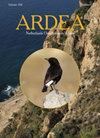安第斯湿地濒危哥伦比亚角云雀种群现状、生境利用及繁殖生物学研究
IF 1.3
4区 生物学
Q3 ORNITHOLOGY
引用次数: 1
摘要
哥伦比亚角雀Eremophila alpestris peregrina是哥伦比亚安第斯高原的一种特有鸟类,由于栖息地的丧失而濒临灭绝。因此,关于该物种的人口状况、生境利用和生殖生物学的资料是至关重要的。我们在La Copa水库研究了这些方面,在那里发现了该物种最大的种群。首先,我们确定了它存在于水库周围的哪些位置。在这些地点,我们用固定宽度的样带对其在不同栖息地的丰度和密度进行了8个月的估计。我们通过12个月的行为观察和巢穴追踪来监测其生殖生物学。该物种仅存在于植被稀疏的平原地区,利用草地、农田或两者的混合。不同生境间种群密度差异显著,粗放型草地种群密度高(5.7只/ha),而农牧混交型生境种群密度中低(1.1只/ha),耕地种群密度为0.41只/ha。这些差异可能与放牧的存在、洪水动态、多年生牧草的密度、草地的大小以及用于作物生产的有毒农药的有害影响有关。我们估计整个水库中有133 - 230只(95% CI)个体(大多数为成虫)。这是一个重要的数字,因为它可能占哥伦比亚角雀种群的13-23%。最后,我们展示了这些云雀繁殖周期的数据。本文章由计算机程序翻译,如有差异,请以英文原文为准。
Population Status, Habitat Use and Breeding Biology of the Endangered Colombian Horned Lark in an Andean Wetland
The Colombian Horned Lark Eremophila alpestris peregrina is an endemic bird of the Colombian Andean Plateau that is endangered due to habitat loss. Information on the population status, habitat use and reproductive biology of this species is therefore vital. We studied these aspects in the La Copa reservoir, where the largest population of this species is found. First, we determined at which locations around the reservoir it was present. At these locations, we used fixed-width transects to estimate its abundance and densities in different habitats for eight months. We monitored its reproductive biology, through behavioural observations and nest tracing during 12 months. The species was only present in plain areas with sparse short vegetation, using grassland, cropland or a mix of the two. Population densities varied significantly between habitats, being high (5.7 birds/ha) in extensive grasslands and medium to low in mixed cropland-grassland (1.1 birds/ha) and cropland (0.41 birds/ha). These differences may be related to the presence of grazing, flooding dynamics, the density of perennial forbs, the size of the grassland fields and the detrimental effect of toxic pesticides used for crop production. We estimated that 133 to 230 (95% CI) individuals (mostly adults), inhabit the entire reservoir. This is a significant number since it may represent 13–23% of the Colombian Horned Lark population. Finally, we present our data on the reproductive cycle of these larks.
求助全文
通过发布文献求助,成功后即可免费获取论文全文。
去求助
来源期刊

Ardea
生物-鸟类学
CiteScore
2.10
自引率
0.00%
发文量
49
审稿时长
>12 weeks
期刊介绍:
Ardea is the scientific journal of the Netherlands Ornithologists'' Union, and is published since 1912. The journal welcomes manuscripts reporting significant new findings in ornithology, in particular those covering the ecology, life history, and evolution of birds, and including sound descriptive work. Ardea publishes Original research papers, Short notes and Book reviews. In addition to the regular three issues per year, Ardea publishes specials that contain conference or workshop proceedings (produced on request).
 求助内容:
求助内容: 应助结果提醒方式:
应助结果提醒方式:


